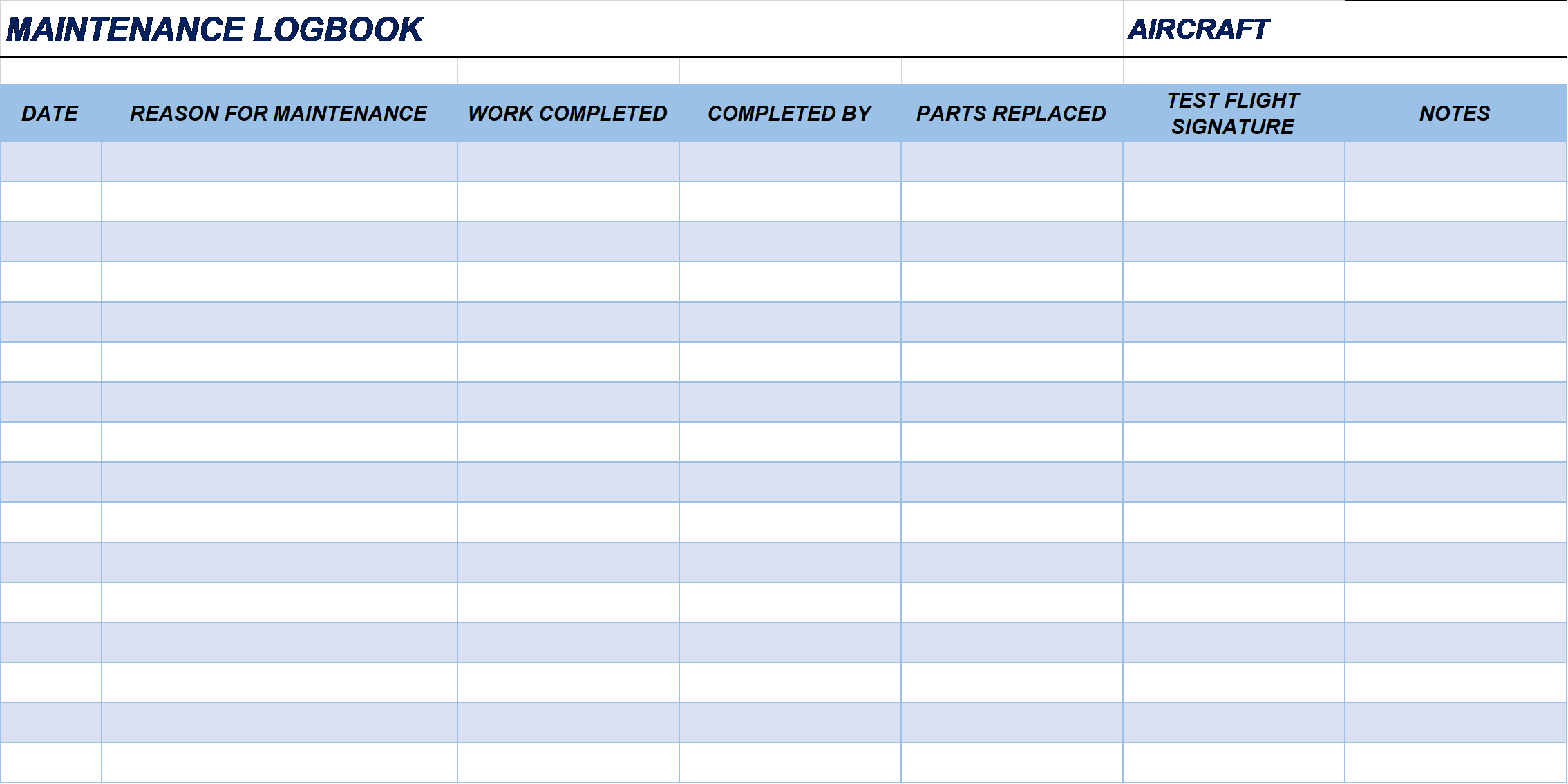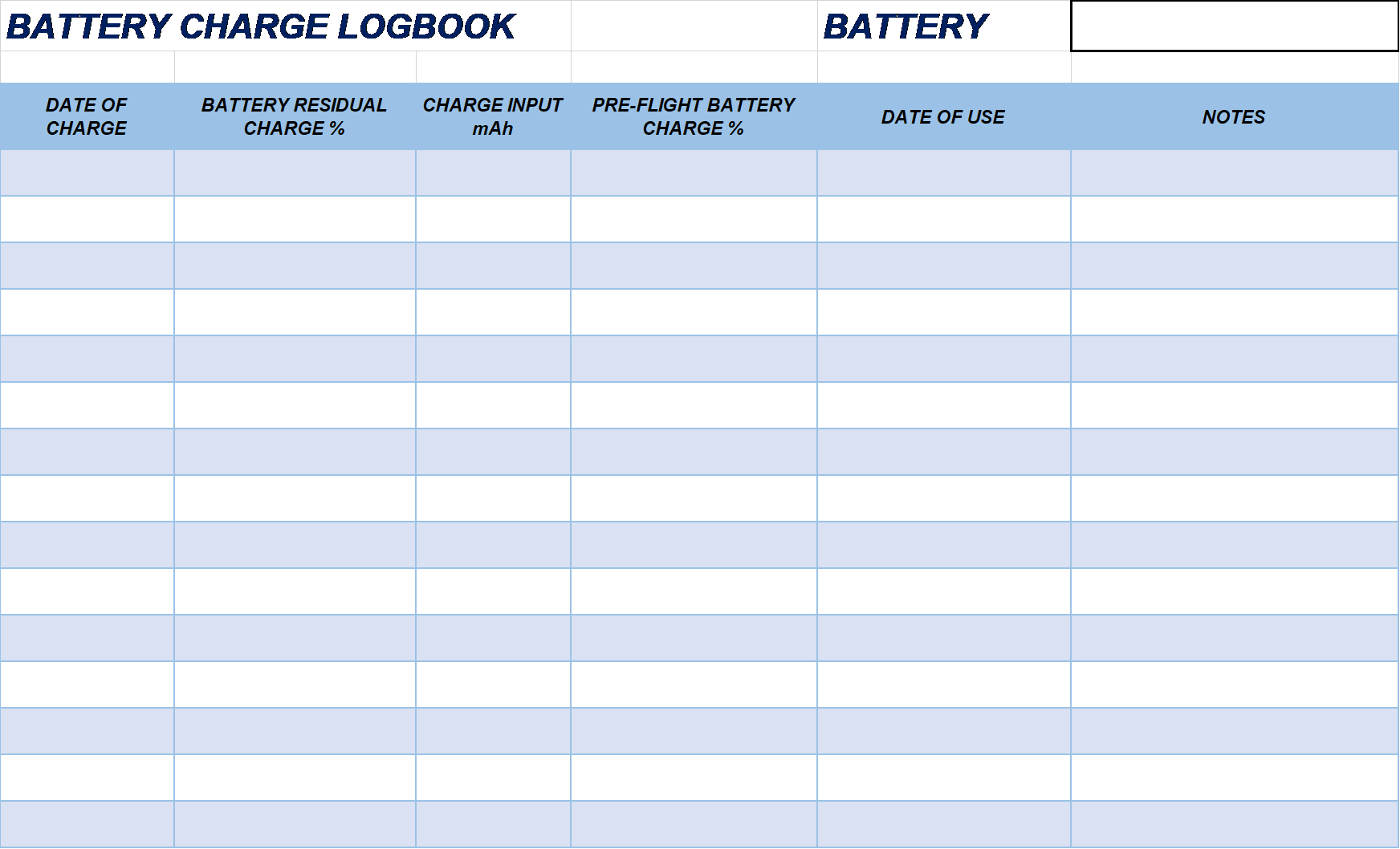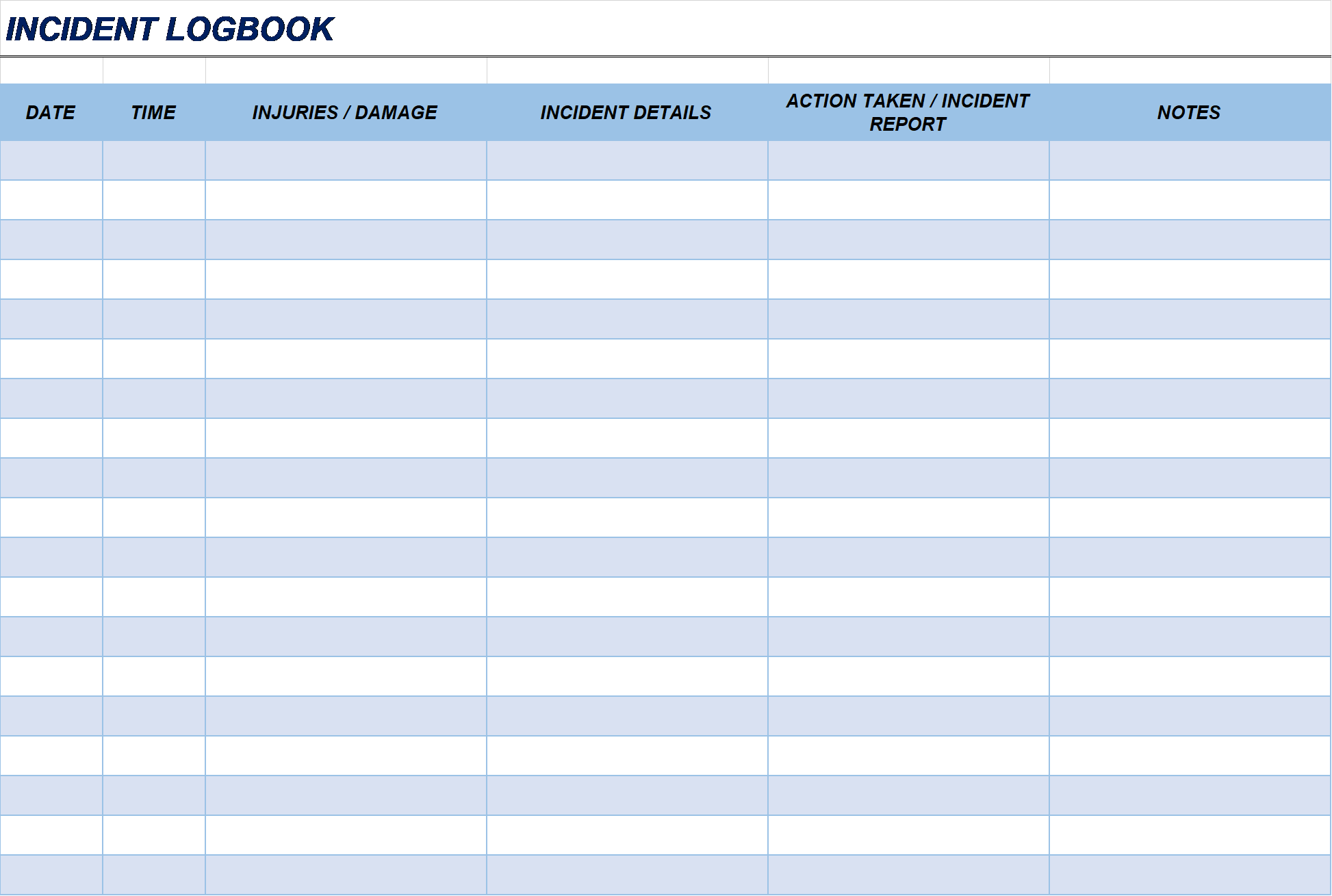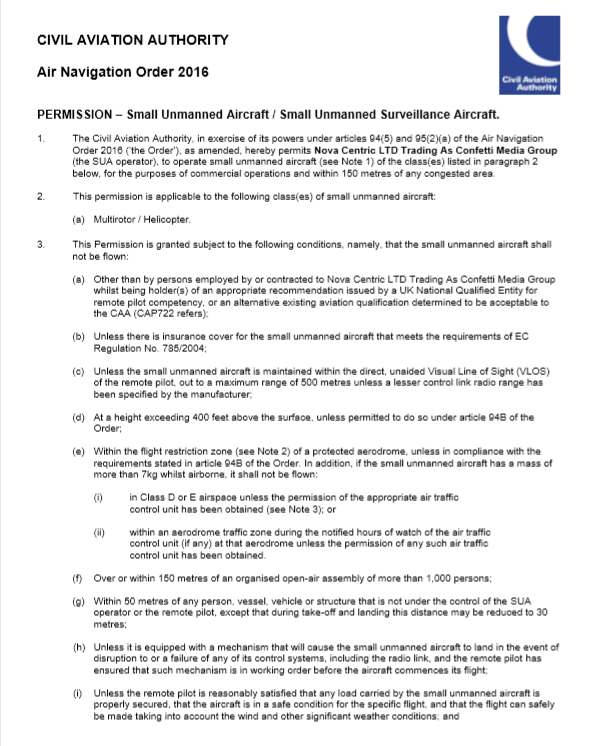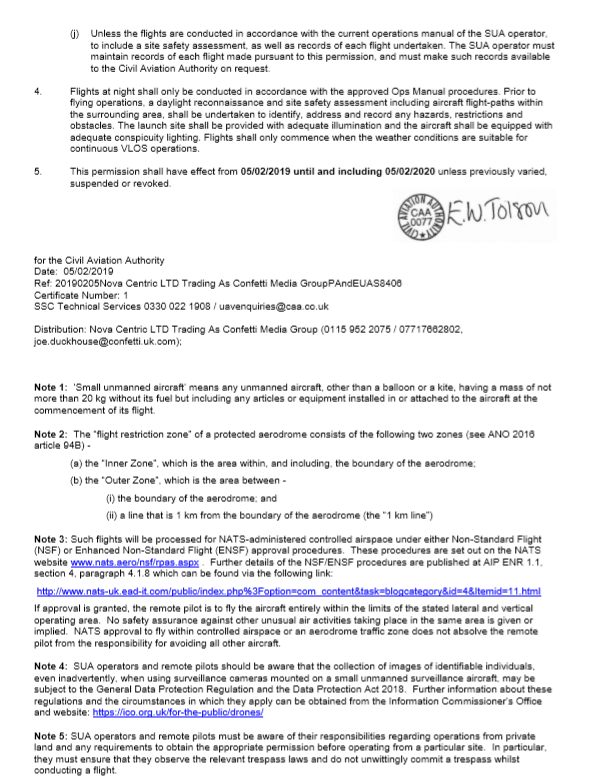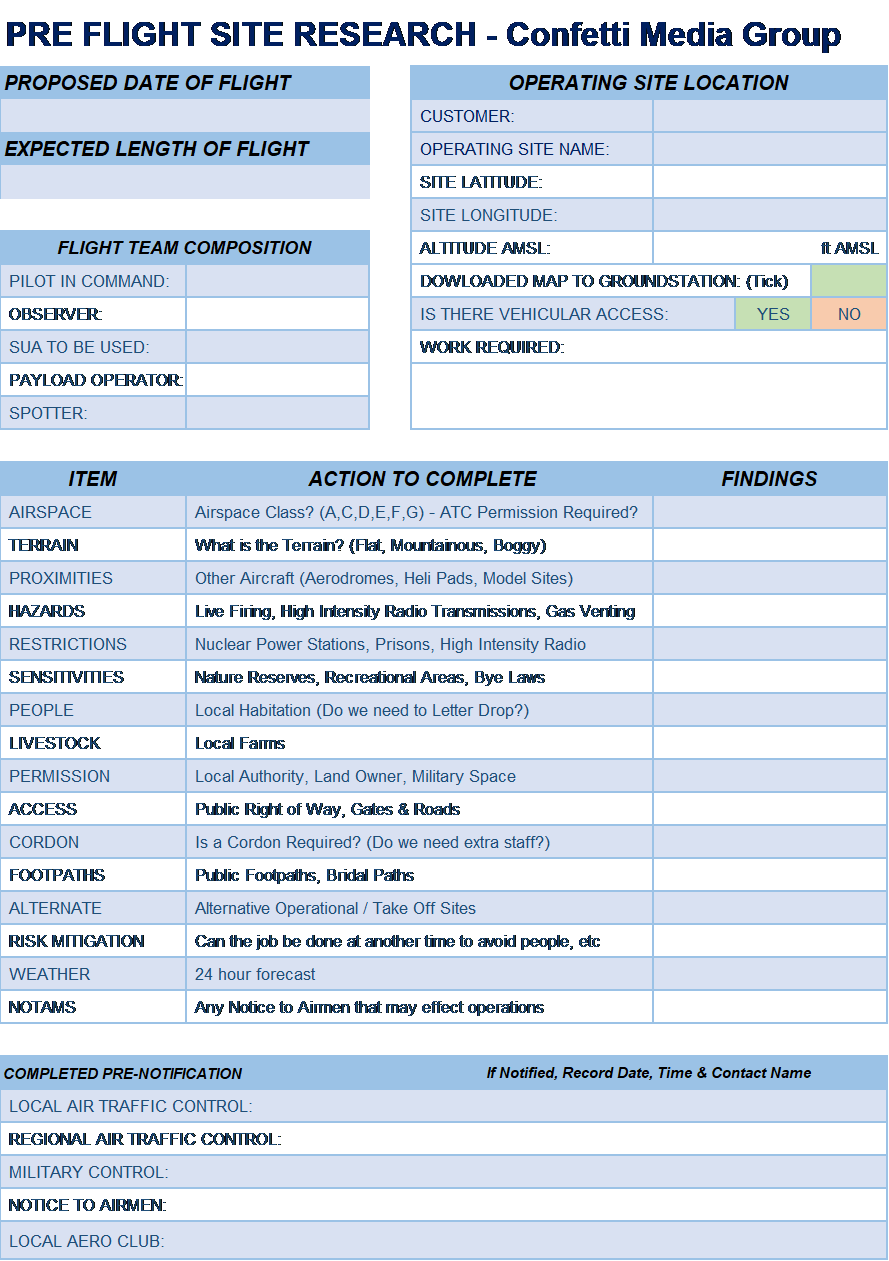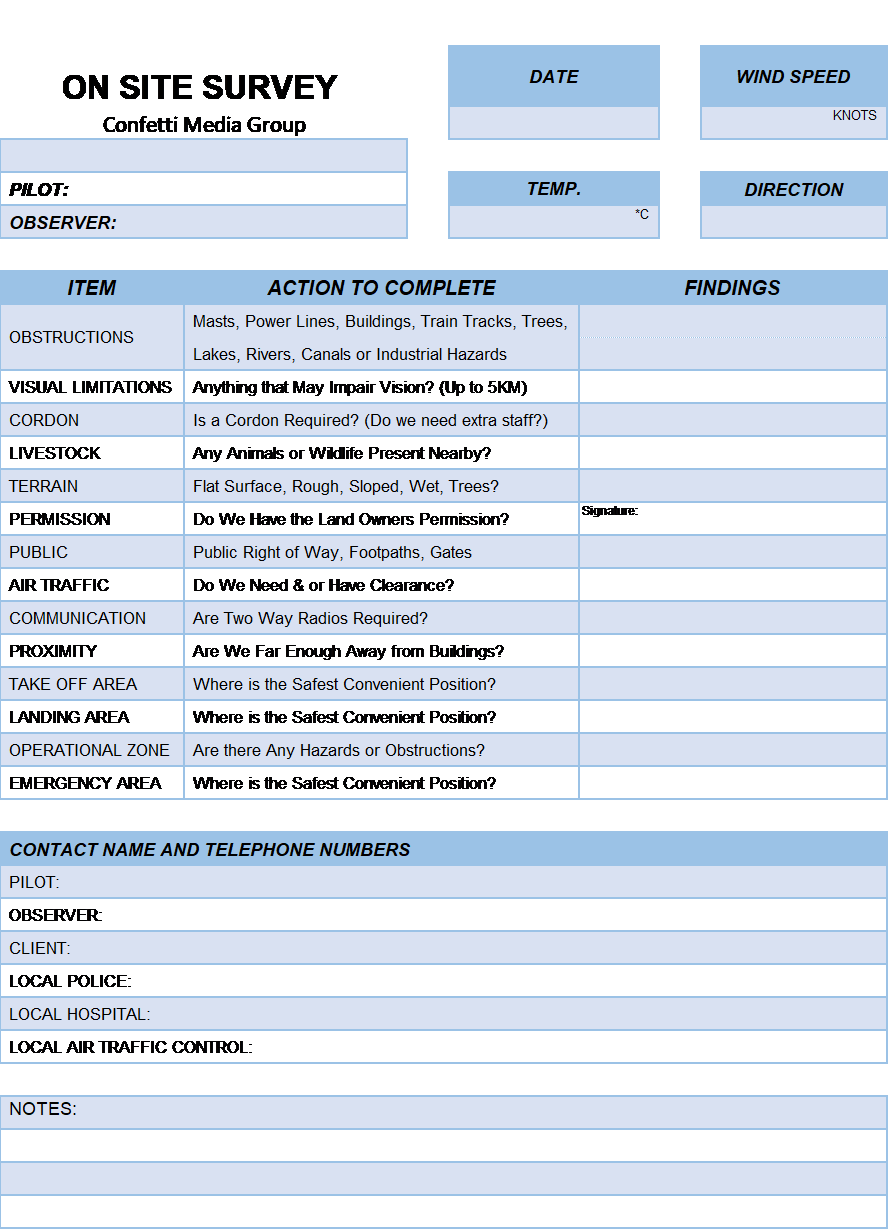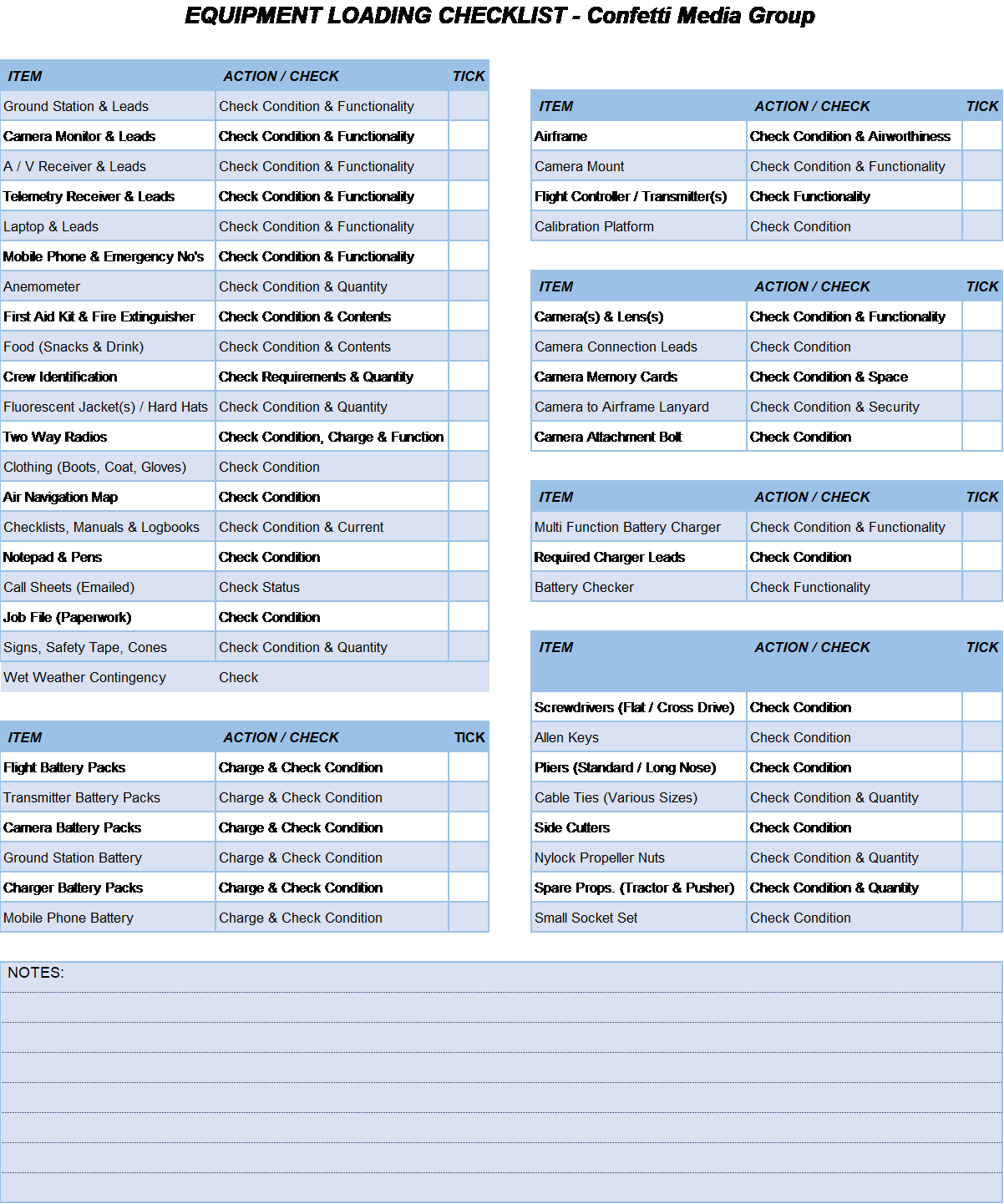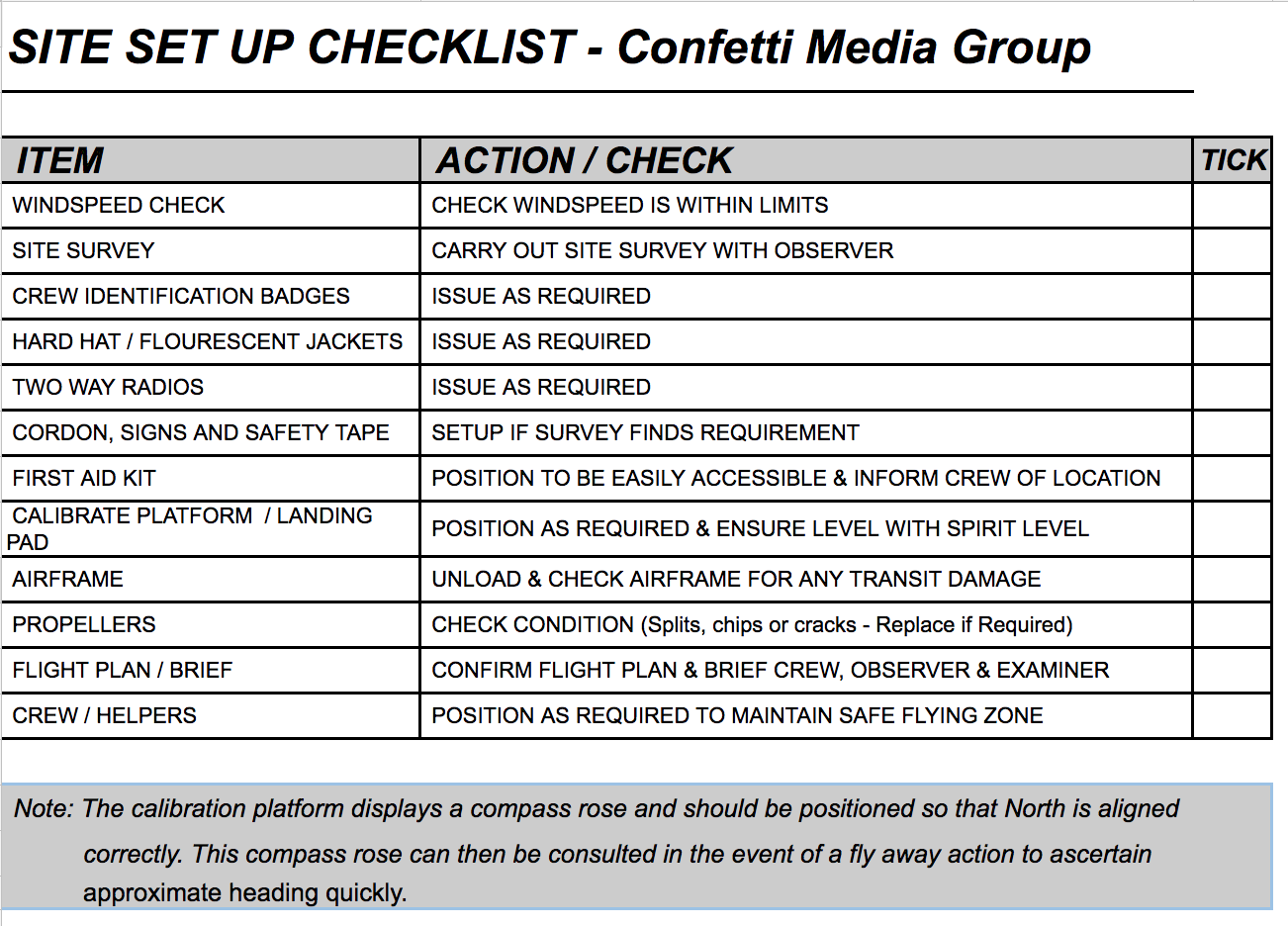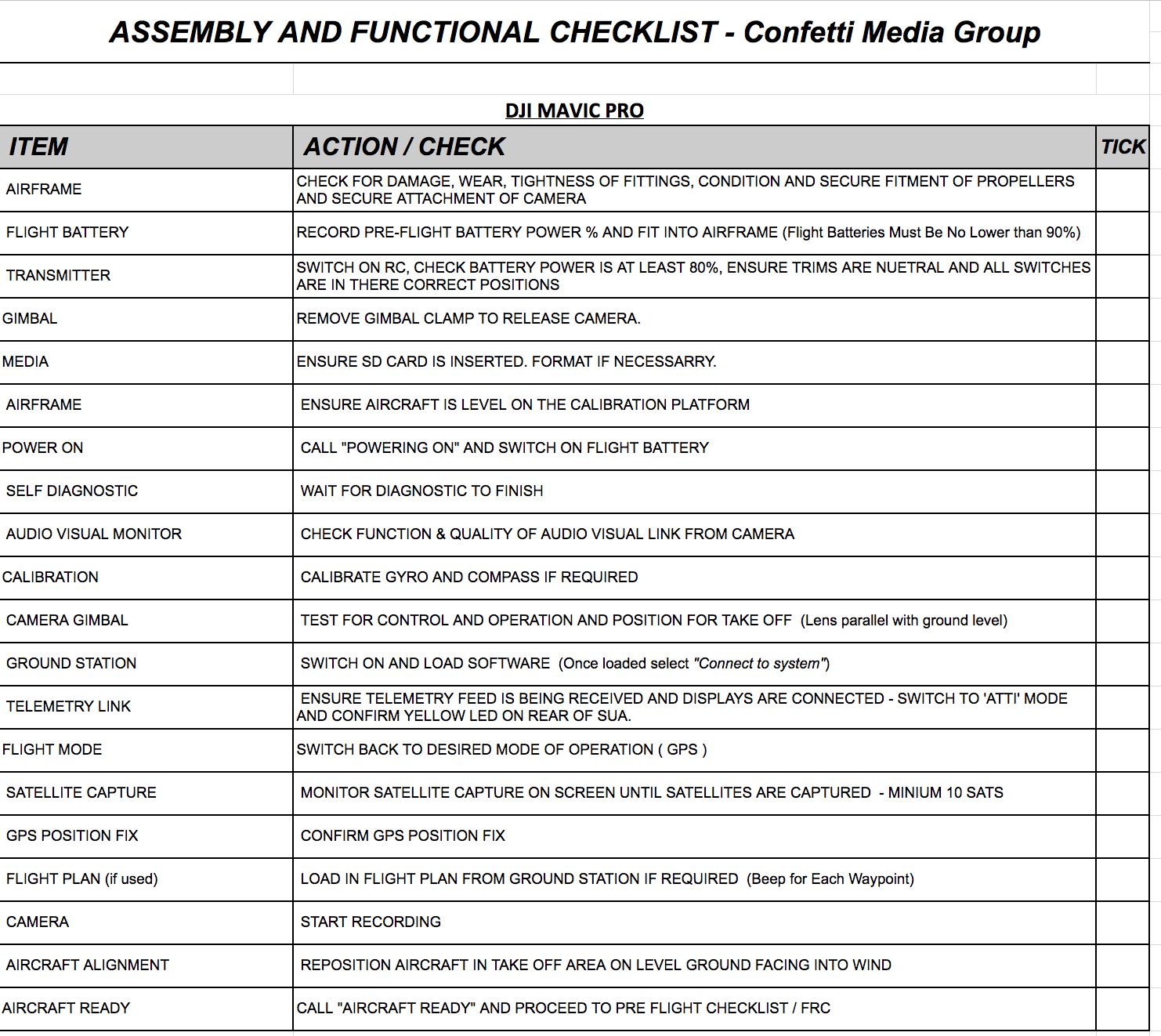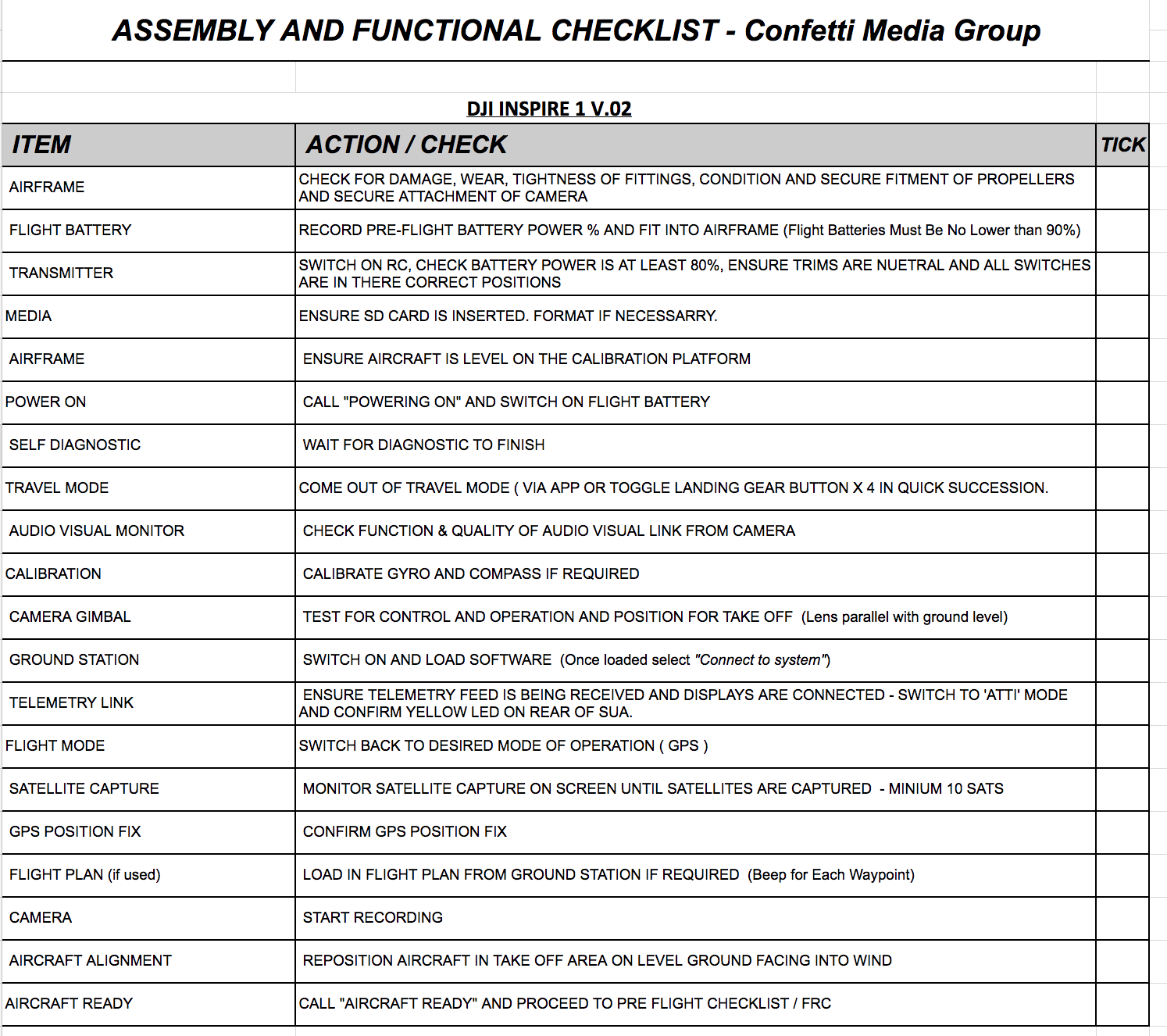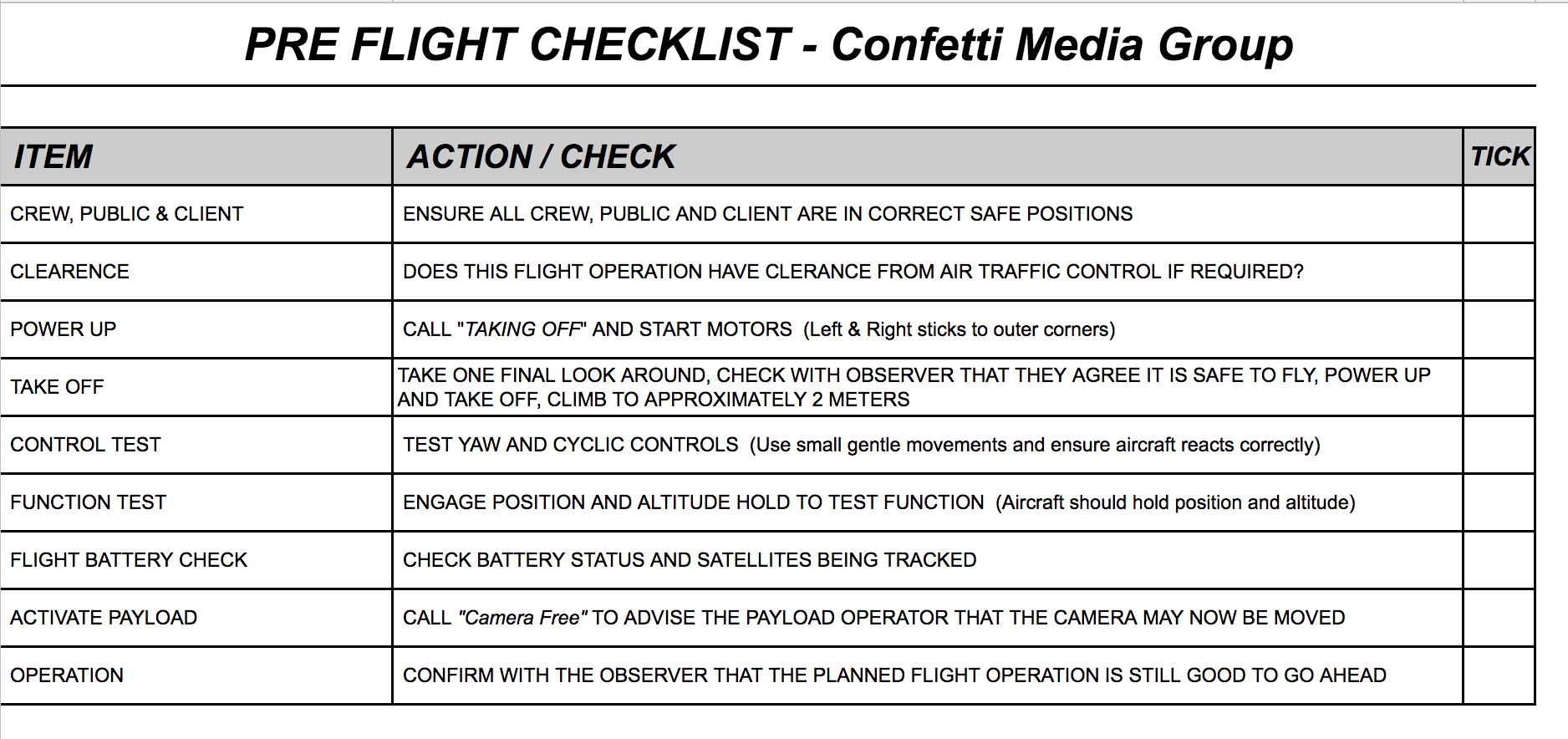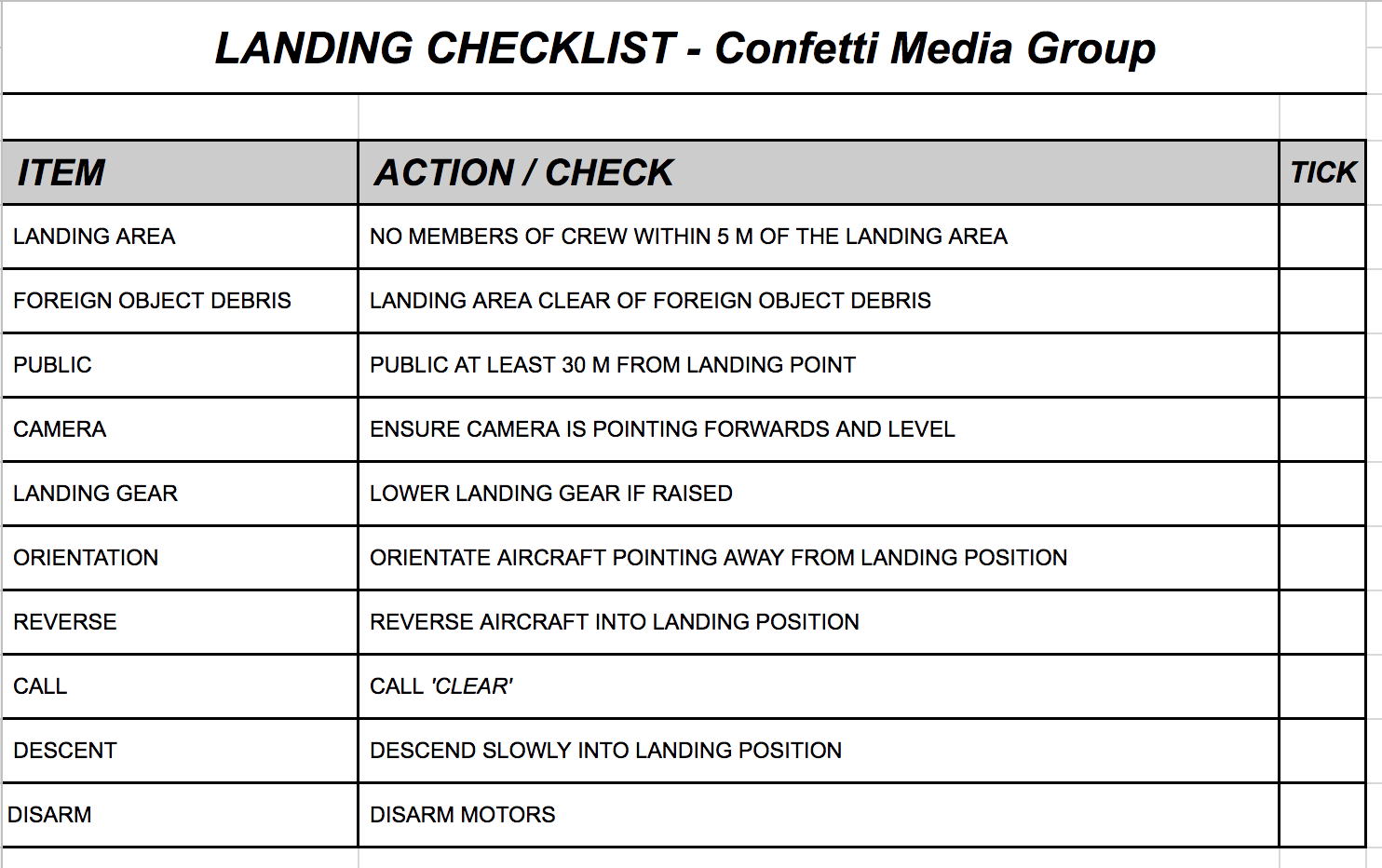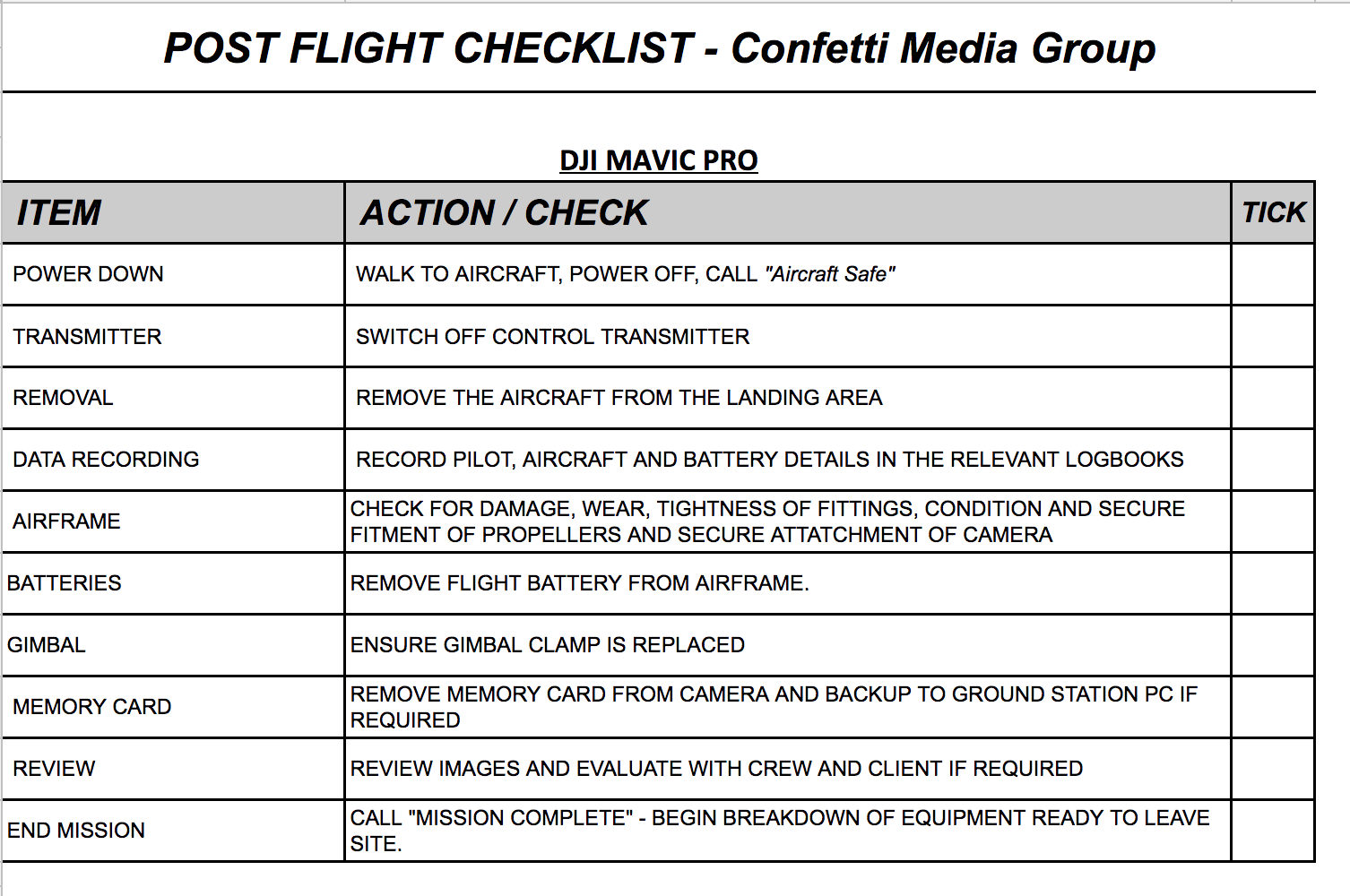CMG SUA Operations Manual v1.3
This Operations Manual describes the organisation, aircraft systems, personnel, flight operations and procedures by which Nova Centric LTD carries out its Small Unmanned Aircraft operations.
Nova Centric LTD is committed to the safe conduct of all its Small Unmanned Aircraft operations and will ensure that the systems deployed are maintained and prepared in accordance with industry best practice, are operated in accordance with the procedures and bounds of this Operations Manual and within any limitation or condition specified in any UK Civil Aviation Authority (CAA) Permission granted for such aerial work.
It is accepted that the contents of this document do not override the necessity of reviewing and complying appropriately with any new or amended regulation published from time to time by the CAA addressed by this document.
For and on behalf of Nova Centric LTD, a company registered in England & Wales c/o Nottingham Trent University, 50 Shakespeare Street, Nottingham, England, NG1 4FQ Registration Number: 04820267
Enquiries regarding the content of this document should be addressed to Nova Centric LTD at the following address:
FAO Joe Duckhouse, Confetti, 6-10 Convent Street, Nottingham, NG1 3LL
Accountable manager: Joe Duckhouse, Nova Centric Ltd.
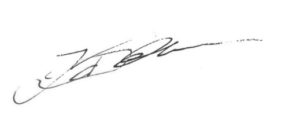
1.1 Purpose
The purpose of this document is to record the key data associated with the safe operation of any Small Unmanned Aircraft (SUA) with a Maximum Take-Off Mass of up to 20 kg by Nova Centric LTD personnel.
1.2 Scope
Nova Centric LTD’s traditional business is further and higher education provision in the creative industries, local broadcast operations and media production and post production services for commercial and internal clients. Its customer base is anyone who needs the services listed above.
Confetti Media Group aims to capture innovative and dynamic video and photography to help enhance the appeal and production values of assets created for local television and journalism, internal marketing departments, commercial clients, and education. This will involve a range of locations and productions as per the brief of the specific client / customer, providing that all safety and best practice guidelines set out in this this document can be met.
1.3 Overarching Strategy
Nova Centric LTD is aiming to grow its student enrolment numbers at both FE and HE levels year on year by providing access to industry standard professionals and equipment within the company as means of guidance and opportunity, allowing students to shadow, learn, and gain experience working on professional production shoots.
This will be complemented by an increase in commercial revenue and local TV viewing figures due to an expanded range of innovative production techniques on offer, of which the safe and considered use of SUA’s is a key part.
Safety is paramount and Nova Centric LTD has put essential safeguards in place to maintain a safe environment for all involved or connected to Nova Centric LTD SUA operations.
1.4 Document Control and Amendment Process
All amendments to this Operations Manual are to be made by Tom Bee and must be recorded in the Amendment Record Page found at the front of this document. Each amendment is identified with a new Version Number, an Amendment Date, and a list of the major Amendments Incorporated. All amendments will be signed off by the Accountable Manager, Joe Duckhouse.
The CAA will be informed of all major updates such as new aircraft or pilots.
All Nova Centric LTD employees will be informed of any changes to this Operations Manual and they must ensure they have access to a current up-to-date version either in electronic or paper format.
1.5 Referenced Documents

2.1 Policy
Safety is the first priority in all Nova Centric LTD activities. The business is committed to implementing, developing and improving strategies, management systems and processes to ensure that all its aviation-related activities uphold the highest level of safety performance and meet national and where appropriate international standards.
Nova Centric LTD’s commitment is to:
- Comply with and, wherever possible, exceed legislative and regulatory requirements and standards;
- Develop and embed a safety culture in all aviation-related activities that recognises the importance and value of effective aviation safety management and acknowledges that safety is paramount at all times;
- Minimize the risks associated with aircraft operations to a point that is as low as reasonably practicable and achievable;
- Ensure that externally supplied systems and services that impact upon the safety of operations meet appropriate safety standards;
- Ensure that sufficient skilled and trained resources are available to implement safety strategy and policy;
- Establish and measure safety performance against realistic objectives and/or targets;
- Continually improve its safety performance; and
- Conduct safety and management reviews and ensure that relevant corrective action is taken.
- Clearly define for all staff their accountabilities and responsibilities for the development and delivery of the company’s aviation safety strategy and performance;
- Achieve the highest levels of safety standards and performance in all its aviation activities;
- Ensure that sufficient skilled and trained resources are available to implement safety strategy and policy
- Actively develop and improve safety processes to conform to world-class standards;
2.2 Safety Management System
Nova Centric LTD has only implemented the rudiments of a full Safety Management System.
The ‘internal’ Safety Objectives are:
- Encouraging an environment whereby safety has top priority and is second nature, and
- Increasing the knowledge on safe operations and practices on the part of its customers.
2.3 Safety Targets
It is the goal of Nova Centric LTD to operate aircraft without harm, injury or damage to any persons or property. The Nova Centric LTD Remote Pilot will comply with all of the safety requirements and limitations of the Permission for Commercial Operations issued by the UK CAA to Nova Centric LTD.
3.1 Organisation
- Organisation Name: Nova Centric LTD
- Trading as: Confetti Media Group
- Organisation Type: LTD
- Organisation Registration Number: 04820267
- Country of Registration: England
Nova Centric LTD has third Party Public Liability Insurance as outlined below:
- Insurer: Flock
- Insurance Registration ID: D-PF-C-245902
- Insurance Policy: UAV pay-as-you-fly insurance for commercial operators (2018 – rev1)
- 3rd Party Liability Insurance: £1,000,000
- Insurance Expiry Date: 04/02/2020
Nova Centric LTD flies the following SUA:
- SUA: DJI Mavic Pro Platinum (M1X)
- SUA Type: Multirotor
- SUA MTOM: 743 g
- SUA Serial No: 08QCF1JP021KAH
- SUA: DJI Inspire 1 – Version 2 (T601)
- SUA Type: Multirotor
- SUA MTOM: 3200 g
- SUA Serial No.: W13DCL21061584
The technical specification for these SUA are attached as Appendix B.
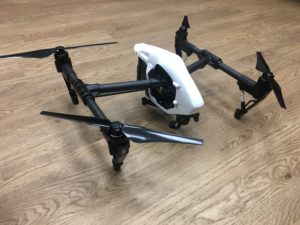
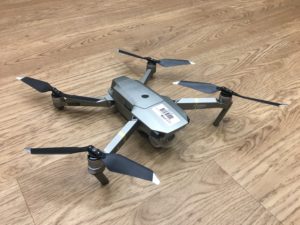
3.2 Structure of Nova Centric LTD
Nova Centric LTD is owned by Nottingham Trent University. The Chief Technical Officer oversees technical operations at Confetti Media Group.
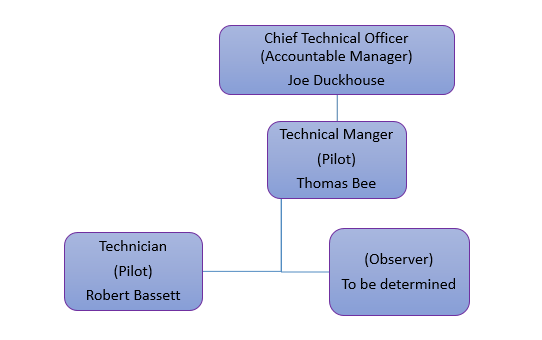
3.3 Nominated Personnel
- Remote Pilot: Robert Bassett
- Pilot Competency Assessment: COP-SU13080748
- Assessed to operate Aircraft Type: Multirotor
- Aircraft Weight Category: < 20 KG
- Remote Pilot: Thomas Bee
- Pilot Competency Assessment: COP-SU13080747
- Assessed to operate Aircraft Type: Multirotor
- Aircraft Weight Category: < 20 KG
3.4 Responsibilities
The Remote Pilot’s responsibilities are:
- Supervising each operation of the SUA.
- Completing the pre-flight risk assessment and mitigating any risks where possible.
- Having confidence that the flight can be conducted safely and the competence to perform that flight.
- Checking that everything is secure on the SUA.
- Ensuring that the aircraft used is airworthy by completing the pre-flight checklist.
- Briefing all crew members prior to a flight to ensure they understand their responsibilities.
- Communicating with client as required to understand the required task.
- Planning each flight in advance and ensuring the right resources are available when required.
- Ensuring that the welfare of themselves or others is not compromised by any planned operations.
- Operating the aircraft within the stated limitations for that particular aircraft.
- Respecting the limitations stated on the Permission for Commercial Operations.
- Ensuring that he or she is of sound body and mind to operate the aircraft.
- Completing all required paperwork such as pilot & aircraft hours, battery log etc. after a flight.
If present, the Observer’s responsibilities are:
- Acting as a link between the Remote Pilot and other crew members.
- Ensuring the Remote Pilot is aware of all relevant developing situations.
- Maintaining constant visual look out for ground and air incursions.
- Ensuring the position of the SUA is known at all times.
- Keeping the Remote Pilot updated with battery status.
- Being prepared to activate the ‘failsafe’ function on the aircraft when required.
- Briefing the pilot after a flight using Threat and Error Management techniques to help the pilot improve his or her competency.
If present, the Payload Operator’s responsibilities are:
- Ensuring the camera or sensor is operational. (Fully charged, empty memory card fitted, lens clean)
- Ensuring the camera or sensor is securely mounted. (the Remote Pilot must confirm this also)
- Ensuring the camera or sensor is switched on and operating correctly before activation of the aircraft.
- Ensuring the camera or sensor is switched off and images saved after the aircraft is made safe.
- Ensuring operational safety: it is every crew member’s responsibility to alert the observer to any changing situation which may cause threat to any aircraft, property or person present.
- Ensuring the camera or sensor is rotated to the stored position for take-off and landing procedures.
3.5 Areas of Operation
The areas of operation are primarily in rural and semi-rural locations outside. However, due to the nature of the business other areas may need to be considered, such as urban or indoors. The viability of all areas considered for production must always be researched and scrutinised before decisions by the accountable manager as to the suitability of that location for planning and pre-production.
3.6 Types of Operation
The anticipated types of operation are:
- Aerial Photography
- Aerial Videography
Operations that are conducted during daylight will be within standard Visual Line of Sight (VLOS) limitations of 400 ft (121.92 meters) above ground level and at a maximum distance from the Remote Pilot of 500 metres provided the Remote Pilot can see the Small Unmanned Aircraft (SUA) in good Visual Meteorological Conditions.
Prior to all night time operations (where night time is defined as the time from half an hour after sunset until half an hour before sunrise, sunset and sunrise being determined at surface level), a daylight reconnaissance and site safety assessment including aircraft flight-paths within the surrounding area, shall be undertaken to identify, address and record any hazards, restrictions and obstacles. The launch site shall be provided with adequate illumination and the aircraft shall be equipped with adequate conspicuity lighting. Flights shall only commence when the weather conditions and visibility of the SUA are suitable for continuous VLOS operations.
The minimum separation from people, vessels or vehicles not directly under the control of the Remote Pilot will be 50 metres. The same distance will be maintained from structures not under the control of the Remote Pilot
3.7 Supervision of SUA Operations
Nova Centric LTD will comply with the requirements of CAP382, Mandatory Occurrence Reporting.
Any Incidents or Occurrences will be dealt with by Nova Centric LTD as follows:-
Incident Handling
In the event of any Incident, the severity must be assessed. The following lists should help to identify Minor and Major Incidents:-
MINOR INCIDENTS
- Any unusual or unexpected flight behaviour from the aircraft which does not result in damage or loss
- Any failure of any aircraft system which does not result in damage or loss
MAJOR INCIDENTS
- Any unusual or unexpected flight behaviour from the aircraft which results in damage or loss
- Any significant damage to the aircraft caused by an aircraft system failure
- Any significant danger or damage to persons, possessions or property during Flight Operations
- Any public encroachments or aircraft incursions which required preventative measures to avoid
Incident Logging
All MINOR incidents will be logged in the Aircraft Operating Hours Log as well as the Nova Centric LTD Incident Log. Upon noting a minor incident the logbook should be checked for similar occurrences. If a minor incident occurs three times then an investigation should be initiated to identify the cause and consider implementing steps to reduce the likelihood of this incident occurring again.
All MAJOR incidents require an investigation as outlined in the Investigation Procedure section. The Incident Log should also be updated.
Investigation Procedure and Report
Any investigations undertaken by Nova Centric LTD will follow the procedure shown below to generate an Investigation Report with the following contents:
INTRODUCTION
The introduction contains the context for the Incident and confirms the major facts as to the companies and people involved, why they were present and the reason for the flights being carried out.
DESCRIPTION OF EVENTS
This is a factual account of the events leading up to and immediately after the incident as well as the incident itself. Its aim is to provide an agreed basis upon which the analysis is carried out.
Importantly any assumptions should be clearly stated and all data provided should have its authenticity and derivation stated. If there are doubts then these should also be clearly articulated so that future analysis can take this into account.
ANALYSIS
The analysis of events sets out to find explanations for what is described in the description of events. Wherever possible the analysis draws upon known concepts, models and physical understanding to ensure that the events as described have a logical explanation.
The analysis should set the scene for any conclusions and provide traceability from the facts to the conclusions in a logical and auditable way.
CONCLUSIONS
The conclusions are derived from the analysis, which themselves are based upon the facts in the description of events or the facts as they pertain to concepts, models and physical understanding exposed within the analysis. A strong conclusion is one where this traceability is good and can stand up to scrutiny.
RECOMMENDATIONS
The aim of the recommendations is to provide the organisations or personnel identified for the report with those items and actions that can lead to a safer operation and which address the short-comings highlighted through the investigation process.
Mandatory Occurrence Reporting
The UK Air Navigation Order states “Any incident which endangers or which, if not corrected, would endanger an aircraft, its occupants or any other person” is a reportable occurrence. CAP382 now requires that a reportable occurrence is filed on the ECCAIRS European-wide reporting system through the Joint Research Council website at http://www.aviationreporting.eu/aviationreporting.
Incidents involving injury to a person should also be reported by Nova Centric LTD to the Air Accident Investigation Branch by phoning 01252 512299.
3.9 Flight Team Composition
For Confetti Media Group productions, as a minimum, a flight team must consist of a Pilot and an Observer.
If it is determined through planning and pre-production that more crew are required due to a more complex shoot, then the flight team must be scaled up accordingly and the PIC must be satisfied that there is adequate crew in place.
3.10 Operation of Multiple Types of SUA
Normal operations by Nova Centric LTD will normally only be conducted with one SUA in the air at one time. However there may be occasions where Nova Centric LTD considers it safe to operate two SUAs at the same time to meet a client’s requirements and in this instant there will be two Remote Pilots, one controlling one aircraft, but there will be a Remote Pilot appointed who will have the overriding responsibility for the safe operation of both aircraft.
3.11 Qualification Requirements
Nova Centric LTD will ensure that all Nova Centric LTD pilots acting as the Pilots-in-Command of its SUA hold a SUA pilot competency assessment or qualification recognised by the CAA.
3.12 Crew Health
All Nova Centric LTD pilots-in-command and other crew members will be instructed in the ‘I’M SAFE’ mnemonic and will be trained to use it as a proactive self-assessment tool.
It is the responsibility of the individual to determine if they are in a physically and mentally fit condition to participate in Nova Centric LTD operations.
All crew members must be capable of clearly reading a vehicle registration number plate from twenty metres.
Crew members shall not attend a flight operation if they are under the influence of alcohol.
Nova Centric LTD also has a strict no drugs policy. All Flight Crew members taking prescription drugs should seek professional guidance and also advise the Remote Pilot.
Any crew member who begins to feel unwell and are unable to continue with their assigned responsibilities should advise the Remote Pilot or Observer immediately.
3.13 Logs and Records
Nova Centric LTD will maintain up-to-date information and operational logbooks for:-
- Aircraft and Pilot Operating Hours
- Battery Charge
- Aircraft Maintenance
- Incidents / Accidents
See Appendix C for examples of these logbooks.
3.14 Operator Training Programmes
All Nova Centric LTD pilots acting as Pilots-in-Command on commercial drone operations will be subject to regular assessment by the Nova Centric LTD accountable manager on an annual basis for competency and currency.
To maintain currency a pilot must have flown a SUA for more than 2 hours in the previous 3 months.
3.15 CAA Permission
A copy of the Permission for Commercial Operations issued to Nova Centric LTD by the CAA is included in this Operations Manual as Appendix D.
4.1 Role Training and Currency
All Nova Centric LTD pilots will have to hold a pilot qualification recognised by the CAA for SUA commercial operations and will be assessed by the Nova Centric LTD Accountable Manager as being knowledgeable and competent to fly Nova Centric LTD’s SUAs in Nova Centric LTD’s potential operating environments.
All Nova Centric LTD pilots will be expected to maintain flying skills currency through hands-on flying with Nova Centric LTD SUAs, other SUAs they have access to or appropriately-configured simulators.
4.2 Area of Operation
The anticipated areas of operation are rural and semi-rural environments across, but not limited to, the East Midlands. On occasion, urban and indoor operations may be required. The viability of all operation are to be determined on case by case basis.
Commercial drone operations conducted in UK airspace will be assessed in advance using comprehensive site risk assessment forms and procedures, see Appendix E.
4.3 Operating Limitations and Conditions
All Nova Centric LTD operations will be conducted within the limitations stipulated within CAP393 Articles 94, 94A, 94B and 95 and CAP722 or as updated in the PfCO issued by the CAA to Nova Centric LTD.
The standard limitations are:
- Visual Line of Sight (VLOS) in accordance with Article 94
- To a maximum vertically above ground of 400’
- Up to a maximum distance from the Remote Pilot of 500m
providing in both cases the pilot can identify and monitor the SUA
- Not over or within 150m of Open Air Assemblies of more than 1000 people (Article 95)
- Not over or within 150m horizontally of a Congested Area (CAP722)
- Not within 50m of people not under the control of the Remote Pilot of the SUA although this distance is reduced to 30m during take-off and landing (Article 95)
- Not within 50m of Vehicles, Vessels and Structures not under the control of the Remote Pilot (Article 95)
- Not inside or within 1km of a flight restriction zone (consisting of the ATZ, Runway Protection Zones and Additional Boundary Zones) of a protected aerodrome without ATC or CAA permission.
4.4 Methods to Determine the Intended Tasks and Feasibility
For all Nova Centric LTD commercial drone operations, the designated Remote Pilot will assess the intended task using the Pre-Flight Site Research Form (see Appendix E). Details captured on the form from the customer will include:-
- Contact Details
- Work Required
- Date and Time Constraints
- Location of Work (Latitude and Longitude if possible)
- Landowner Details
- Other Nearby Air Users (if known)
- Any Other Relevant Information
A completed Pre-Flight Site Research Form will be retained for at least three years for future reference if required.
The designated Remote Pilot will be responsible for determining the method of operation for the intended task, identifying resources and assessing the task’s feasibility. If he or she has any reservations, he will discuss the reservations with the Nova Centric LTD Accountable Manager before proceeding with the task.
4.5 Operating Site Planning and Assessment
As part of the research into task feasibility, the Nova Centric LTD Remote Pilot will use whatever tools and facilities deemed necessary and available to him. These may include:
- Client Information
- Current and Relevant Aeronautical Charts
- Integrated Aeronautical Information Package – United Kingdom
- SkyDemonLight and NoFlyDrones- Online Aeronautical Charts
- com to confirm NOTAMs
- Google Earth
- Google Maps
The task will only go ahead if the Remote Pilot is satisfied the necessary controls and safeguards can be put in place for a safe operation.
4.6 Communications
Contact telephone numbers for the following will be recorded on the Pre-Flight Site Research Form, and the On-Site Survey Form, which can be found in Appendix E, before departure to the site:
- Landowner(s)
- Observer and Crew
- Client Contact
- Local Police Station
- Local Hospital
- Local Air Traffic Control (ATC)
- Local Air User Clubs
Where possible, contact will be made with the Landowner(s) and the ATC before any physical site survey in conducted.
4.7 Pre-Notification
Pre-Notification is required if a planned flight operation is to take place within two and a half nautical miles of an aerodrome or airport with an Aerodrome Traffic Zone (ATZ) or Controlled Traffic Zone (CTR). The Remote Pilot will contact the ATC in person at least twenty four hours before the planned flight to advise the controller of the planned flight operation. Contact details for the tower will be recorded on the relevant On-Site Survey Form.
If there is a local air user club nearby the Remote Pilot will endeavour to contact the club and enquire about any likely activity on the day of the proposed flight operation.
If the planned flight operation is to take place in areas where there is likely to be members of the public, the Remote Pilot will inform the local police. The contact and telephone number will be recorded on the On-Site Survey Form.
If the flight operation is to take place in a highly populated area, such as a housing estate, a leaflet drop and/or a door-to-door advisory campaign will be considered at least seven days in advance to advise members of the public of proposed flight operations. Operations in public areas where public address systems are available require a Nova Centric LTD crew member to announce planned flight operations at least one hour before commencement.
All relevant Nova Centric LTD crew members will be advised of a planned flight operation at least twenty-four hours in advance.
4.8 Site Permissions
The designated Remote Pilot will obtain permission from all relevant landowners or land occupiers over which flight operations are to be conducted. Where possible, permission will be sought in writing. Where it is available in writing a copy of the permission will be carried on site. No flight operations will commence without permission, either written or verbal, from the relevant land owners or occupiers for the main take off and landing site.
4.9 Weather
In the week leading up to any flight operation the designated Remote Pilot will obtain long, medium and short range weather forecasts. Twenty four hours before the proposed flight operations the Remote Pilot will determine whether the planned flight operations will go ahead.
Weather and other forecasts, such as solar activity, will be obtained using readily available resources, which may include:-
- UAV Forecast
- XC Weather
- Weather Channel
- Weatherpro
- Accuweather
4.10 On Site Procedures
Before setting up on-site in accordance with the On-Site Arrival Checklist, see Appendix F, the Remote Pilot or a designated crew member will carry out the following measurements:
- GPS/GLONASS satellite coverage, a minimum of seven satellites over a good spread will be required for all operations, using the aircrafts GPS system.
- Wind speed at surface level, using a handheld anemometer.
If the Remote Pilot feels confident that the proposed flight operations can be safely carried out, then the operation can progress and the Remote Pilot can complete the On-Site Arrival Checklist.
The Remote Pilot will then carry out the On-Site Survey, see form in Appendix E, to familiarise him or herself with the local geography of the site. This will be completed by physically walking around the site to identify any hazards and any identified will be marked on the On-Site Survey Form. Where an Observer is present, the Observer will accompany the Remote Pilot.
The Remote Pilot must be satisfied that all risks identified are acceptable and will sign off the On Site Survey before proceeding to the next stage.
4.11 Assembly and Functional Checks
The SUA will be assembled and checked in accordance with the relevant SUA Assembly Checklist, see Appendix F.
The Remote Pilot will check the day prior to the flight operation that all necessary software and firmware updates have been completed on the SUA to be flown and if necessary a test flight has been conducted.
4.12 Pre-Flight Checks
The SUA will be prepared for flight by the Remote Pilot following the Pre-Flight Checklist, see Appendix F.
4.13 Flight Procedures
When the Remote Pilot is satisfied the SUA is ready for launch, he or she will follow the Launch Checklist, see Appendix F.
During flight, the Remote Pilot will conduct situational awareness updates with the Observer if present. Situational awareness updates will include:
- SUA position and responsiveness
- SUA battery status
- Horizon scans and airspace assessments
- Landing site incursions
- Alternate landing site incursions
- Air incursions (air users / birds)
- Potential adverse weather changes
- Ground incursions, in particular dangers to the Remote Pilot
Prior to landing, the Remote Pilot will go through the Landing Checklist.
4.14 Post Flight and Between Flight Checks
The SUA will shut down, made safe and checked in accordance with the Post Flight Checklist, see Appendix F.
4.15 Emergency Procedures
The Emergency Procedures for Nova Centric LTD’s SUA are set out in Appendix G.
- Manufacturer: DJI
- Model: Inspire 1 v2 – T1601
- Type-Configuration: Multirotor
- Overall Dimensions (H x L x W): 438 Mm x 451 Mm x 301 Mm
- Weight: 3.5 Kg (maximum takeoff weight), 2.845 Kg(empty)
- Propulsion: Battery Powered Electric, 4 motors
- Energy Store: LiPo, Required voltage: 26.3V
- Flight Control Computer: DJI -DJI Inspire 1 Integral
- Lost link response: If GPS is available, return-To-home-point, automatic landing
- C2 Link: Line-of-Sight, spread spectrum R/C 5.8 GHz
- Maximum range: 2 Km or 1.2 Miles
- Flight Control Station: DJI C1.
- Operating temperature range: -10 C to + 40 C
- Maximum operating wind speed: 10 m/s or 22 mph
- Average flight time: 18 Minutes
- Maximum speed: 22 m/s or 49 mph (Atti mode, no wind)
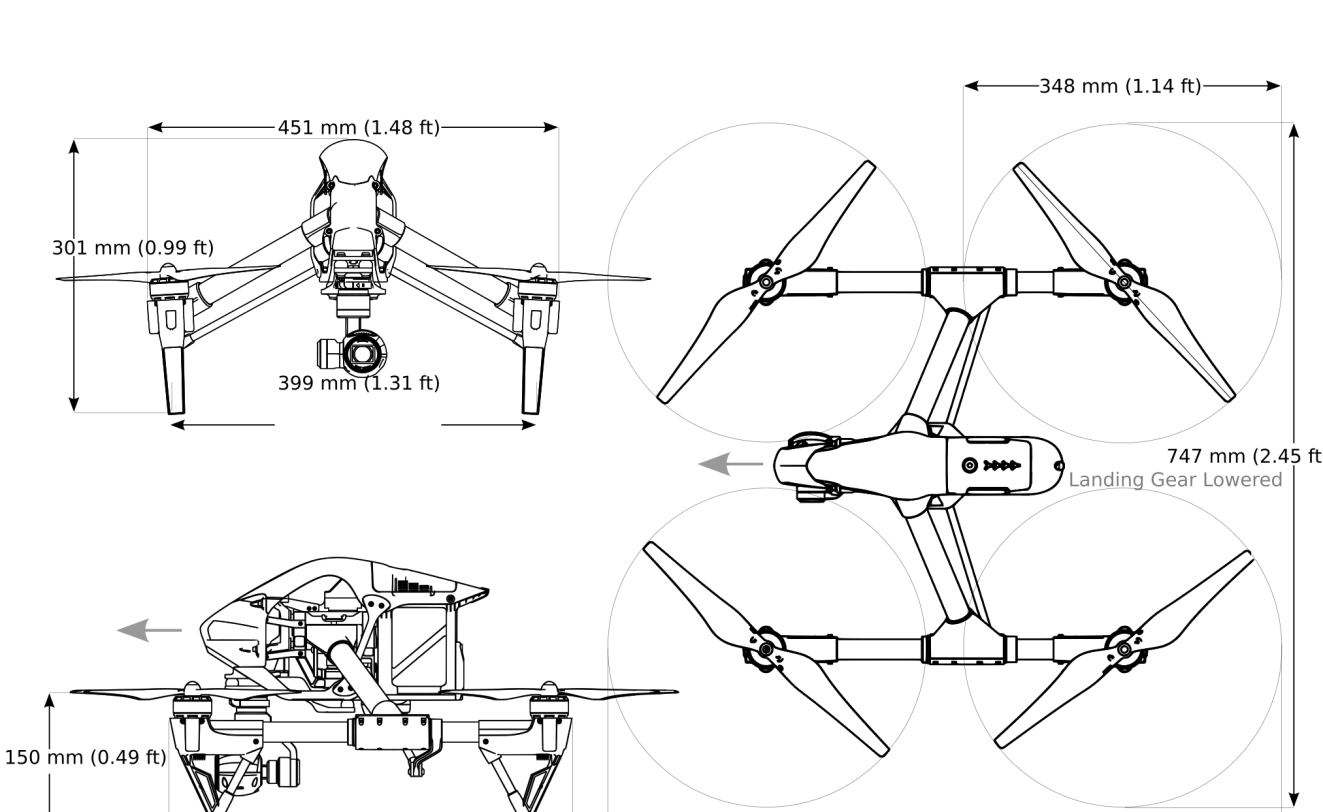
- Manufacturer: DJI
- Model: Mavic Pro Platinum (M1X)
- Type-Configuration: Multirotor
- Overall Dimensions (H x L x W): 83mm x 83mm x 198mm (Folded)
- Weight: 0.743 Kg
- Propulsion: Battery Powered Electric, 4 motors
- Energy Store: LiPo, Required voltage: 11.4v
- Flight Control Computer: DJI -DJI Inspire 1 Integral
- Lost link response: If GPS is available, return-To-home-point, automatic landing
- C2 Link: Line-of-Sight, spread spectrum R/C 5.8 GHz
- Maximum range: 15km or 9.3 miles
- Flight Control Station: DJI Mavic Pro Controller
- Operating temperature range: 0 C to + 40 C
- Maximum operating wind speed: 10 m/s or 22 mph
- Maximum/Average flight time: 30/21 Minutes
- Maximum speed: 40.4 mph (Sport mode, no wind)
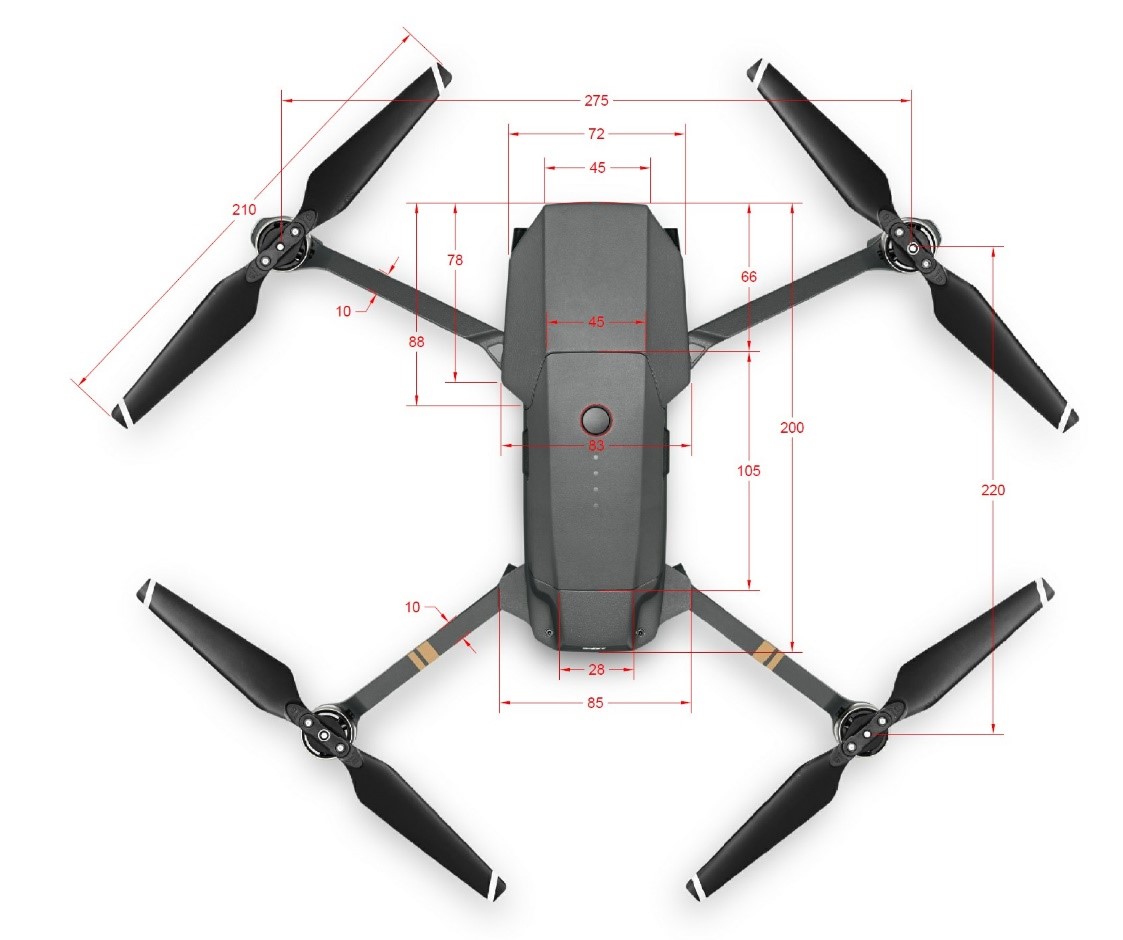
F.1 Pilot incapacitation
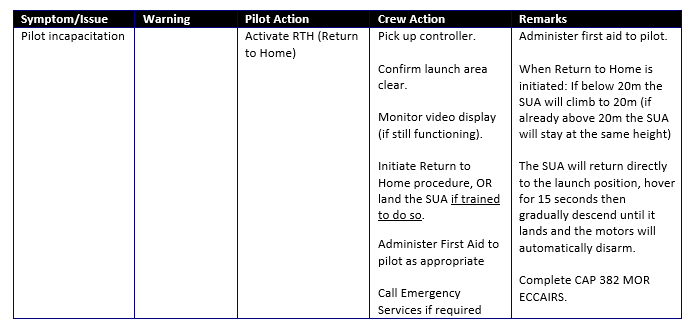
F.2 Airspace incursion

F.3 Loss of control data link
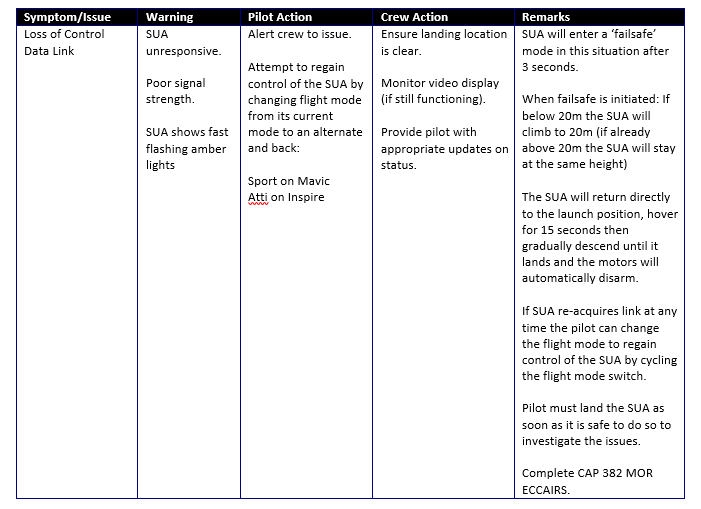
F.4 Rogue SUA
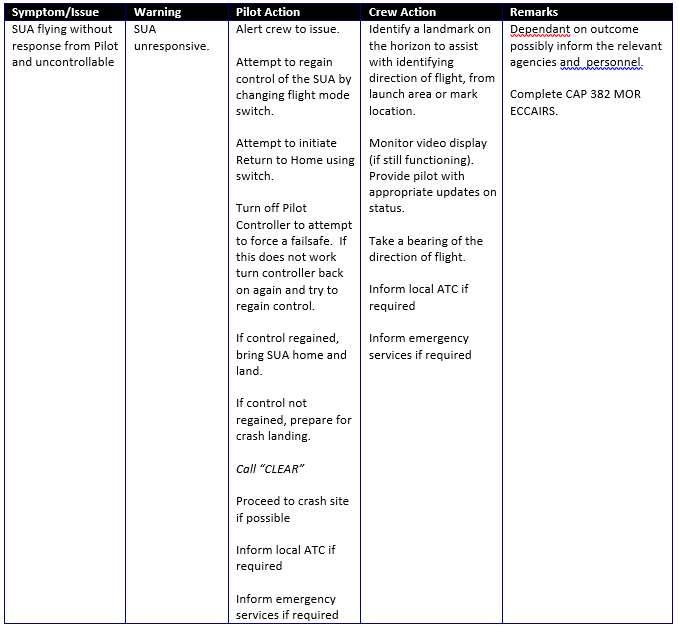
F.5 Loss of power (SUA)
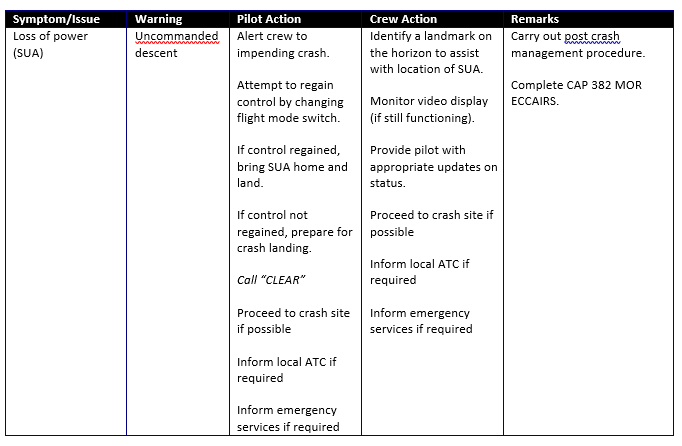
F.6 Loss of power (Ground control equipment)
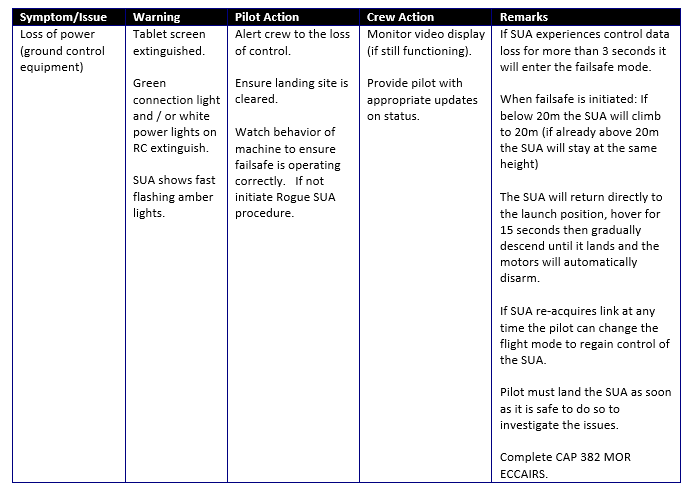
F.7 Unexpected behaviour in flight

F.8 Lithium polymer battery fault
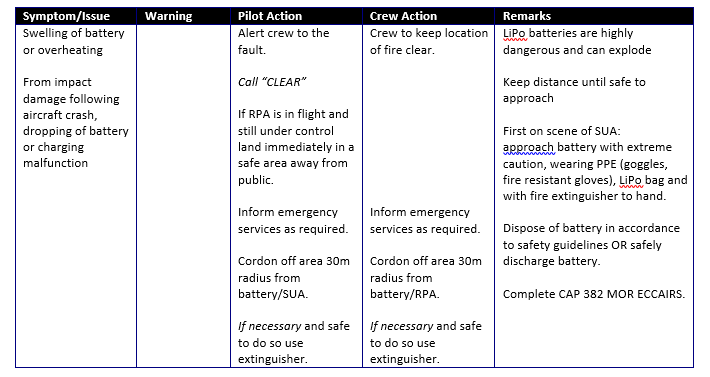
F.9 SUA fire

© Copyright Nova Centric LTD – 2019
All rights reserved. Copies of this publication may not be reproduced for personal, company or organisational use without the expressed permission of Nova Centric LTD.


